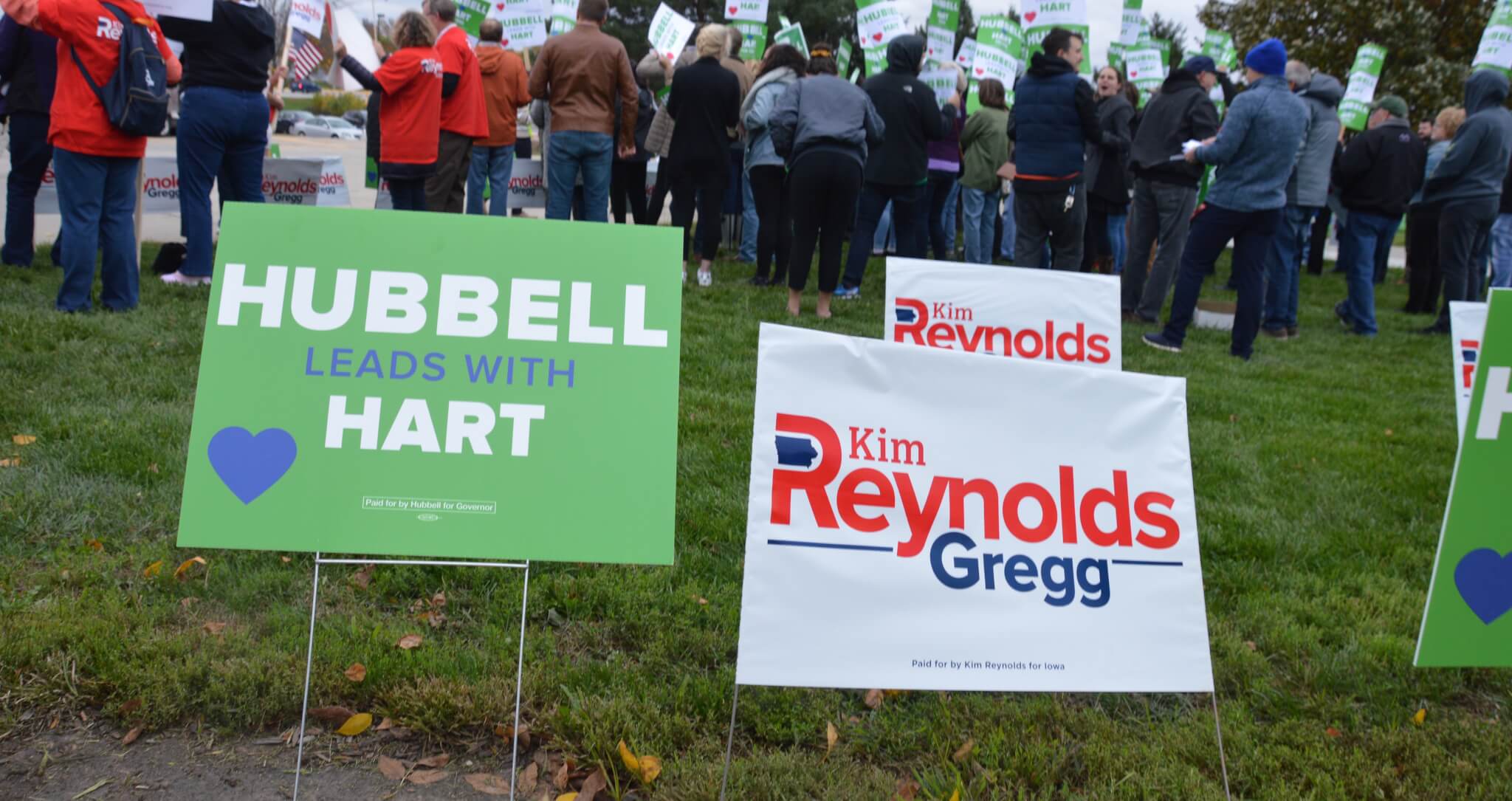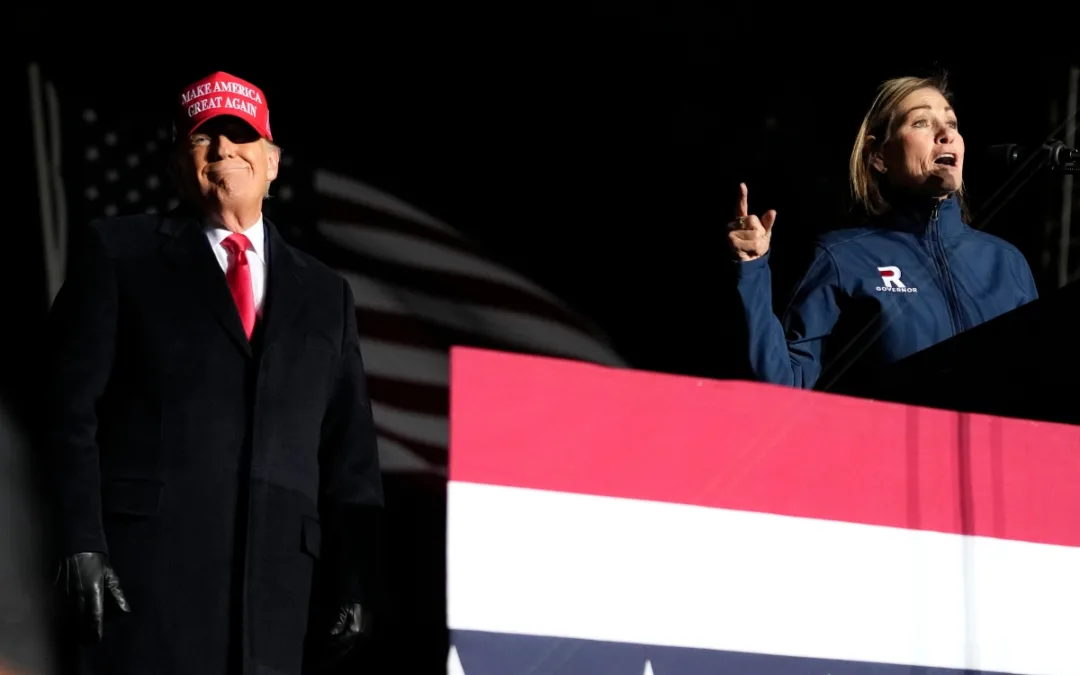
Two waves hit Iowa on Tuesday. Unfortunately for Democrats, the red one was just a little bit stronger and in just the right places for Republicans to win statewide and in specific state legislative seats.
The election results continued the trend of intensifying polarization in Iowa and national politics, exacerbating both parties’ weaknesses and strengths in different communities. That process started many cycles ago, but Donald Trump really sped things up.
Fred Hubbell carried only 11 counties, a steady decline from Barack Obama’s 38-county win in 2012, though better than Hillary Clinton’s 2016 performance where she won just six.
And yet, despite that disparity with Kim Reynolds in county wins, Hubbell still came just three percentage points short. His 47.4% to 50.4% loss was the closest governor’s race since the 1950s, and he was buoyed by massive turnout and dominant wins in Iowa’s urban centers. Hubbell came out of Polk County with a 35,000-vote lead, thanks in part to Democrats’ sweeping victories in the suburbs.
He garnered over 623,000 votes statewide, the most ever for a Democratic gubernatorial candidate since the 1960s. That was an incredible accomplishment, but Reynolds simply turned out even more.
It was all, at least, an improvement for Democrats here over 2016. While the party saw movement toward them in suburban areas in 2016, they still came up frustratingly short in key legislative districts. This year, the dam finally broke on the political realignment among upper-income and higher-educated voters, and Democrats picked up seven Iowa House seats in the Des Moines, Cedar Rapids and Cedar Falls suburbs. That also helped Cindy Axne defeat David Young, a very strong incumbent Republican who won his last race by 14 points.
Another positive sign was the lack of third party defections. Trump carried Iowa with 51.1% of the vote, only a bit higher than Reynolds’ 50.4%. Hubbell closed the 2016 gap by getting to 47.4%, far better than Clinton’s 41.7%. The difference was in part thanks to few voters picking Libertarian Jake Porter, who got 1.6%, or Gary Siegwarth, who received 0.5%.
Even in places like Story County, where Clinton lost a ton of votes at the ISU campus precincts to third parties, the third party total for the county this year was under 3%. It seems younger voters this time realized the need to vote for Democrats no matter what. Hubbell carried Story County 59% to 39% and racked up a huge 9,000-vote margin.
But strong Republican turnout and lopsided margins in rural counties added up. Reynolds carried counties like Humboldt with 68%, Davis with 66%, Montgomery with 67% and Mitchell with 60%.
However, while much attention in aftermath analysis has been paid to the state’s four northwestern counties (Reynolds got a +15,729 vote margin from them), it’s the Eastern Iowa counties that are just as interesting. Hubbell struggled along the Mississippi River counties, losing some and not taking others by large-enough margins.
Hubbell only carried Dubuque County by 565 votes, a place Democrats used to rack up margins of 6,000 to 9,000. He lost Jackson County, where Obama carried 58% of the vote, and Muscatine County, where Obama got 57%.
Democrats had already started to struggle in these places before Trump (Bruce Braley also lost both), but these counties used to provide important bases of Eastern Iowa support. Des Moines County, home to Burlington, was one bright spot at least. Hubbell won it with 53%, ten points better than Clinton’s 2016 performance.
So, while Democrats solved two of their biggest problems in Iowa (base turnout and capitalizing on suburban momentum), they failed to fix two others (rural Republican turnout and blue-collar defections). Democrats’ better performances in the congressional races showed a major statewide win is perhaps still possible, just difficult with the changing trends.
But the results were very bad news for Democrats’ hopes of ever retaking either legislative chamber. There we saw the biggest impact of the shifting voter loyalties.
Iowa House
Democrats picked up seven House seats (all suburban) on Tuesday and lost two. They may yet win one more in Decorah after late-arriving absentee ballots are counted in Democrat Kayla Koether’s race, where she trails Michael Bergan by just eight votes.
The bulk of the wins came in the Des Moines metro, where the party swept all five heavily-contested battlegrounds. Jennifer Konfrst, Kristin Sunde, Heather Matson, Karin Derry and Kenan Judge all captured Republican-held seats. A full sweep is extremely difficult to do in these kinds of races, and even with the changing suburban trends, there were some very impressive victories there against entrenched incumbents.
Derry beat Representative Jake Highfill by 200 votes in a district where registered Republicans outnumber registered Democrats by more than 2,300. Judge picked up the Dallas County suburbs seat that Democrats didn’t even field a candidate for in 2016.
The party also picked up a seat in the Cedar Rapids suburbs with Molly Donahue’s win and one in Cedar Falls where Dave Williams defeated the well-known and powerful incumbent Walt Rogers.
But the party had a brutal surprise loss in Southeast Iowa [Update: Democrats aren’t conceding this race yet with outstanding ballots]. Phil Miller lost by less than 50 votes to Jeff Shipley. Even though Jefferson County had one of Democrats’ best early vote performances in the state, lopsided Republican votes in the rural Van Buren and Davis counties hurt Miller. Neither party invested much funds into the race, and unexpected upsets like these typically happen once or twice in wave years.
Blue-collar districts did not go well either. Democrats also lost a seat in Fort Dodge, one that Republicans invested heavily in to capture, though Megan Srinivas kept it close, only losing by 3.5 percentage points.
The biggest longterm problem for Democrats came in a series of losses in Mississippi River counties. Their candidates came up short, sometimes by surprisingly large margins, in the Muscatine, rural Scott County and rural Dubuque County races. Democrats had gone all-out with their spending in the Muscatine and Dubuque seats, and went up late with money in Scott County. Shannon Lundgren won by 13 points in the rural Dubuque district, a race that was expected to be much closer. A Bettendorf suburban-like seat also failed to be close for Democrats.
The party didn’t spend heavily in many rural districts, and many saw such lopsided losses that it wouldn’t have made much difference. Democratic farmer David Weaver kept it close in the Boone and Greene County district, losing only by 45% to 52%. Tim McClimon only trailed by nine points in the rural Clinton County district.
Where does that leave the party for its future chances of an Iowa House takeover? In a better position, but still a very difficult one.
If Koether ends up winning, Democrats will net six seats and be at a 47-53 minority in the House. If she loses, it’ll be 46-54. Where else could Democrats win in the future to get to 51?
Republican John Landon’s HD 37 in Ankeny will be the top target if Democrats get a stronger candidate next time. Gary Mohr held his Bettendorf seat by ten points, but that could be another suburban seat they could flip with a more extensive effort. Democrat Eric Gjerde ran a hell of a race for the other suburban Cedar Rapids seat, but Ashley Hinson may simply prove to be too popular of an incumbent.
Democrats also nearly got a surprise upset in Mary Ann Hanusa’s Council Bluffs district, where Steve Gorman came within about 100 votes. That side of town has more of the upscale precincts than Council Bluffs’ west end.
But outside of that, the prospects just aren’t that great. Retaking the Fairfield-based district is a possibility, but if some of those Eastern Iowa districts remain un-winnable even with heavy spending, Democrats have a real problem. Suburban and urban districts alone simply don’t add up to 51.
And two rural seats could be at risk if their popular Democratic incumbents ever leave. We don’t have the governor race’s numbers broken down by legislative districts yet, but one would assume Reynolds carried Todd Prichard and Bruce Bearinger’s rural Northeast Iowa seats by a good margin. Neither Democrats had Republican opponents this year, but they too may have gotten surprised like Miller did.
The best news for Democrats is that several of these new Des Moines-area seats they now hold could solidify as strong districts for them, ones they don’t have to spend much money on in the future. Derry and Matson will likely remain swing seats, but Sunde and Konfrst’s districts look to be solid blue now. And Judge could turn into a very strong incumbent with crossover appeal that scares off Republican challengers. That would free up otherwise-expensive races for Democrats to invest more heavily into difficult blue-collar and rural seats.
Still, the path to 51 votes is extremely narrow if Iowa’s partisan trends continue to hurt Democrats in blue-collar areas.
The situation is much more dire in the Senate.
Iowa Senate
Democrats went into election night with 20 seats in the Iowa Senate. They ended the evening with 18. Republicans now hold a 32-18 majority in the chamber.
Here too, Iowa’s political realignment was at work, though Republicans’ strong campaigns gutted out a couple of very close wins. Seven Senate races were decided by six points or less. Republicans won five of those, two of which were pick-ups, three were defends. Democrats won two of them. Knocking off Rick Bertrand in Sioux City was a pick-up; holding on to Amanda Ragan’s Mason City-based seat was a defend. Democrat Kevin Kinney’s reelection in a rural district that takes in part of Johnson County was an easier victory.
Two of Republicans’ pick-up seats were in Eastern Iowa in those same blue-collar, Mississippi River counties that frustrated Hubbell. Carrie Koelker defeated incumbent Tod Bowman in the Jackson County and rural Dubuque SD 29 seat. Chris Cournoyer captured Rita Hart’s old Clinton County-based SD 49 district.
Zach Nunn, as expected, picked up SD 15, which covers Jasper County and the eastern rural part of Polk County. Newton used to be a reliably Democratic town, but hasn’t been in recent years.
Republicans also defended the Mark Chelgren district down in Ottumwa and Fairfield, one of Democrats’ best pick-up opportunities. Marianette Miller-Meeks won with just 52% of the vote. They also held on to Senate Majority Leader Jack Whitver’s Ankeny-based district by just three points, despite Democrats’ all-out investment for Amber Gustafson and the blue suburban wave. A late challenge to Republican Roby Smith in Bettendorf did not pan out. He won by six points.
Democrats’ one pick-up victory came in Sioux City, where Jackie Smith narrowly defeated incumbent Rick Bertrand. He was the only Republican who essentially ran his race outside of the party structure.
Where does that leave the future of the Iowa Senate? In Republican hands for quite a while. This deficit is simply too much to make up in one or possibly even two cycles.
There are a few opportunities next time around. Democrats now control both House seats in Brad Zaun and Charles Schneider’s suburban Des Moines seats. Both are strong incumbents, but if the suburbs keep trending more and more blue, especially in the year that Trump is back on the ballot, Democrats could capture there.
Other avenues for gains are limited. The six seats that Democrats lost in 2016 will be up again, but all are located in rural and blue-collar districts where the political winds are blowing in the opposite direction. SD 44 in Burlington might be the best option, but even that will be difficult. Democrats needed to pick up at least a few this year to even have a shot in 2020.
The Road Ahead
Tuesday’s results pretty much eliminated any hope of Democrats retaking all of Iowa government for the foreseeable future. Redistricting for the 2022 election could improve things by adding more districts into the Des Moines metro. Still, if Democrats cannot find a solution to their problems in blue-collar and rural areas of the state, they will certainly struggle in legislative races. Statewide victories would still be possible, just very difficult.
It’s not clear when those trends will start to reverse themselves. It may not occur until Trump is off the national political stage, whether that be after 2020 or 2024. He has clearly found a way to motivate rural voters to show up in huge numbers and win over working-class people to the Republican cause.
Democrats scored very important victories with Axne and Finkenauer’s wins. Rob Sand showed that a challenger Democrat can still win statewide. Those didn’t impact control of the state legislative process, but they did help build the bench for the future.
They all found ways to capitalize on helpful political trends and negate damaging ones for Democrats. Maybe others can find solutions in their victories to bring the party back to statewide competitiveness sooner rather than later.
by Pat Rynard
Posted 11/8/18
Politics

It’s official: Your boss has to give you time off to recover from childbirth or get an abortion
Originally published by The 19th In what could be a groundbreaking shift in American workplaces, most employees across the country will now have...

Trump says he’s pro-worker. His record says otherwise.
During his time on the campaign trail, Donald Trump has sought to refashion his record and image as being a pro-worker candidate—one that wants to...
Local News

No more Kum & Go? New owner Maverik of Utah retiring famous brand
Will Kum & Go have come and gone by next year? One new report claims that's the plan by the store's new owners. The Iowa-based convenience store...

Here’s a recap of the biggest headlines Iowa celebs made In 2023
For these famous Iowans, 2023 was a year of controversy, career highlights, and full-circle moments. Here’s how 2023 went for the following Iowans:...






